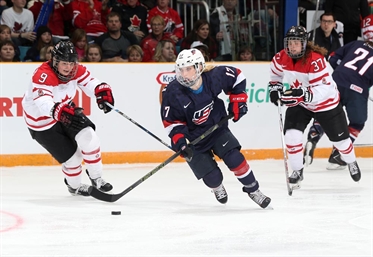Battle of North America
Battle of North America
Who’ll win the golden showdown?

 KAMLOOPS, BC - MARCH 28: USA's Jocelyne Lamoureux-Davidson #17 skates with the puck while Canada's Jennifer Wakefield #9 and Sarah Davis #37 chase her down during preliminary round action at the 2016 IIHF Ice Hockey Women's World Championship. (Photo by Andre Ringuette/HHOF-IIHF Images)
KAMLOOPS, BC - MARCH 28: USA's Jocelyne Lamoureux-Davidson #17 skates with the puck while Canada's Jennifer Wakefield #9 and Sarah Davis #37 chase her down during preliminary round action at the 2016 IIHF Ice Hockey Women's World Championship. (Photo by Andre Ringuette/HHOF-IIHF Images)
In one simple phrase: the Americans probably should, but the Canadians definitely could.
Recently, the balance of power in women’s hockey has trended toward the United States. The defending champions have won six out of the last eight Women’s Worlds. They’re gunning for their third straight title.
Canada, though, has shown an extraordinary ability to rise to the occasion at the Olympics, taking gold four straight times in the new millennium. They broke the Americans’ spirit in the 2010 final (2-0) and broke their hearts with a late comeback and overtime victory in the 2014 final (3-2). The host nation is seeking its first Women’s Worlds gold since 2012.
It all adds up to one of the best rivalries in sports.
“We look forward to playing in the gold medal game,” said U.S. forward Kelli Stack. “It’s what we work for so hard all year long. We’re super-prepared and ready to go. It’s just going to be a lot of fun.”
The U.S. may have better team speed and ability to execute high-skill plays. But the Canadians are very close skill-wise, are arguably mentally tougher, and will have a boisterous home crowd on their side at the Sandman Centre.
“Everybody always seems to find that little bit of extra energy you need to bring your best,” said Canadian coach Laura Schuler. “It’s going to be back-and-forth hockey, and I’m pretty excited about it.”
Last year’s final in Malmo, Sweden was a defensive nightmare, but a dream come true for fans of run-and-gun hockey. Both teams wound up changing their starting goalies. The Americans took a 5-2 lead, allowed Canada to tie it up in the second period in just over two minutes, and then pulled away with a pair of goals, including Brianna Decker’s winner, with under 10 minutes to go.
Will we see more of the same on Monday night?
“We want to come out on top, whether it’s 10-9, 7-5, 2-1, or 1-0,” said U.S. captain Meghan Duggan. “It doesn’t matter. We’re going to fight for the full 60 and we’re just looking forward to a good game.”
The U.S. is renowned for filling the net, and its 22 goals in four games are tops in Kamloops. While tournament scoring leader Hilary Knight (7-2-9), Decker, and the Lamoureux sisters have distinguished themselves, the team has gotten scoring throughout the lineup.
“The depth of our player pool is great,” said U.S. coach Ken Klee. “We obviously have a great team. We don’t want to be a one-trick pony and just have one line scoring while other lines do other things.”
However, the Canadians aren’t far behind with 20 goals. Seeing Natalie Spooner and Meghan Agosta find their offensive game in the hard-fought 5-3 semi-final win over the Finns is a heartening sign for Schuler.
And while the Americans typically dominate games with their power play, they’re not executing at the level they hit in Malmo (44.8 percent). This year, they’re at 30 percent, trailing Canada’s mark of 35.3.
So a special teams battle could favor Klee’s crew, but it’s not an absolute given.
Where the Americans have set themselves apart is defensively. Two goals in four games is extremely hard to argue with. The Canadians, meanwhile, have surrendered eight.
It’s always hard to assess the true quality of these teams’ goaltending, since the netminders are usually not tested to the fullest degree when facing non-North American opponents. The U.S. outshot Canada 37-23 in its 3-1 opening win here in Kamloops, and Canadian starter Emerance Maschmeyer and her U.S. counterpart Alex Rigsby both looked good under the circumstances.
It’ll be fascinating to see where the teams are physically and mentally when they hit the ice.
Physically, the Americans will be better-rested after crushing Russia 9-0 in the early semi-final. That was their second straight blowout against that nation. Mentally, that means they’ll need to guard against overconfidence.
The Canadians’ legs may be a little heavier after their late semi-final, but their battle level has already been raised. They’ll be determined to make it anything but an easy night for the Americans.
“Finland played so well against us,” said Schuler. “They really didn’t give us too much and we had to play our best to pull off that win.”
Klee believes the Americans can triumph if they accomplish three things: “We need to manage the puck well. Our power play needs to be clicking. We need to be good in all areas of the ice.”
Yet if Canadian captain Marie-Philip Poulin plays like a female hybrid of Jonathan Toews and Sidney Crosby, as she did in the last two Olympic gold medal games, and the line of Rebecca Johnston (2-5-7), Jennifer Wakefield (3-3-6), and Brianne Jenner (1-4-5) continues to click, things might not go America’s way.
At least that’s what the pumped-up, pro-Canada crowd will be hoping when the puck is dropped at 19:30 local time.
“Any time you play in Canada, the fans are always loud and crazy,” said Stack. “That’ll be a really fun environment.”
That’s the only guarantee about this final. It’s going to be fun.
Back to Overview

















































